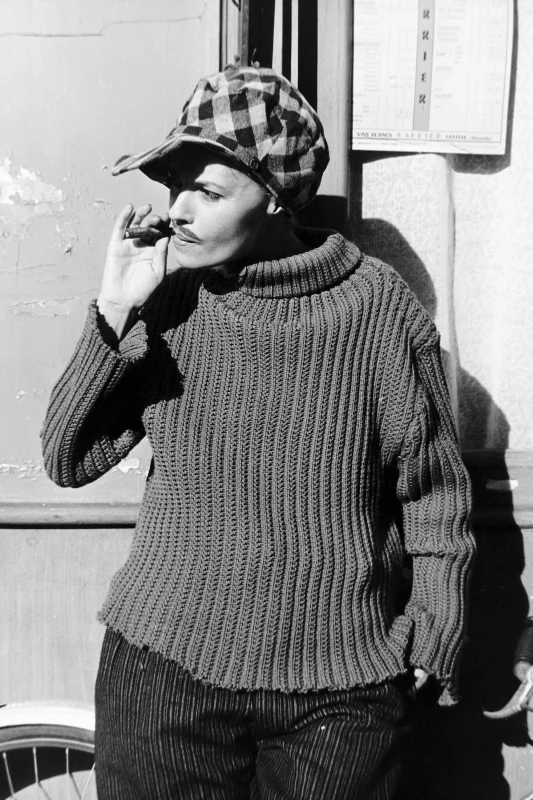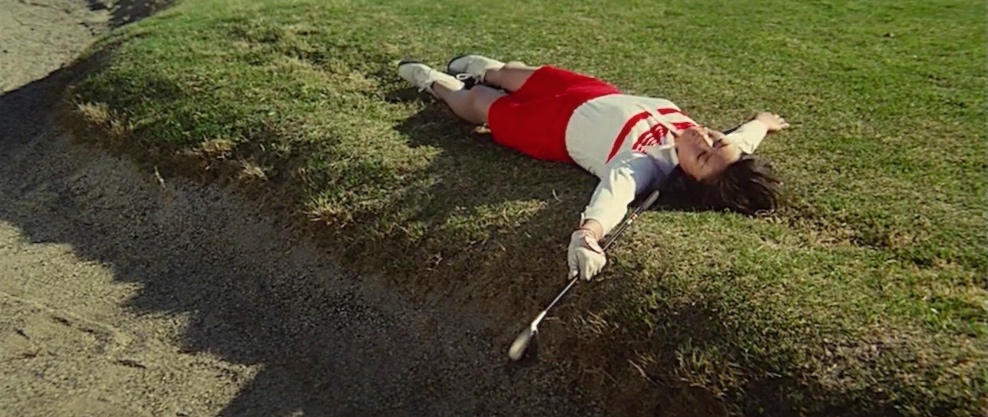“She's a strange breed.” Jules et Jim (François Truffaut, 1962)
Nov
4
sweaters

Catherine (Jeanne Moreau) in a raggedy, moth-eaten sweater and oversized newsboy cap, wears a moustache and smokes a cigar (via). DP: Raoul Coutard.
A movie with gorgeous sweater fashion*
– Jim
Throwing in a little Movember for good measure.
* the Bales 2025 Film Challenge for November is, again, not date-based, but follows a sloppy schmaltzy all-American Thanksgiving-y narrative. Trying to make it work my way.
fashion
– Were you drunk when you did these?
– A little.
– They're very good.Black Widow (Nunnally Johnson, 1954)
Jun
6

Carlotta 'Lottie' Mari (Ginger Rogers) reaching out to Nancy 'Nanny' Ordway's (Peggy Ann Garner). DP: Charles G. Clarke.
悲愁物語 [Hishu monogatari / A Tale of Sorrow and Sadness] (Seijun Suzuki, 1977)
Apr
13
1997 Masters Tournament

Reiko, looking fabulous, dropped down next to a sand-filled bunker. DP: Masaru Mori.
Golf (or a tiger) in honour of Tiger Woods' 1997 Masters Tournament victory.
Reiko (Yoko Shiraki), a professional model – is groomed into playing the circuit by the editor of a golfing fashion magazine. The rookie's unexpected success draws in all sorts of fans, including the obsessive.
– You have a good figure. You could use it to your advantage. Get in touch with me some time.
– I'd love to.Die bitteren Tränen der Petra von Kant [The Bitter Tears of Petra von Kant] (Rainer Werner Fassbinder, 1972)
Jan
31
freebie: high fashion

Fashion designer Petra von Kant (Margit Carstensen) – pouting in her emerald-green dress – is kneeled on a large, sheepskin carpet in front of a huge Baroque painting (Nicolas Poussin's Midas und Bacchus, ca. 1624). In front of her a small bottle of gin and a phone. DP: Michael Ballhaus.
A freebie for someone's birthday, with bonus points for high fashion. Petra von Kant is a fashion designer who, during a particularly icy birthday party, tells the world that her new lover is a woman. Then, one day, said lover returns home to her husband.
With its exuberant costumes and set design, a Greek chorus of mannequins, and Sirk-ish larger- than-life melodrama, Fassbinder's Die bitteren Tränen der Petra von Kant delves deep into the absurdities of love and fancy.
Glen or Glenda (1953)
In an intimate moment, Barbara (Dolores Fuller) hands Glen (Ed Wood) her angora sweater. DP: William C. Thompson.

August 25: someone wears another person's clothes on #NationalSecondhandWardrobeDay
Glen or Glenda [aka Male or Female aka Glen or Glenda, Which Is It? aka I Led 2 Lives] (Edward D. Wood Jr., 1953)
“Give this man satin undies, a dress, a sweater and a skirt, or even the lounging outfit he has on, and he's the happiest individual in the world. He can work better, think better, he can play better, and he can be more of a credit to his community and his government because he is happy.” —Dr. Alton, narrator
In 1953, Christine Jorgensen – who had widely reported sex reassignment surgery the year before – was approached by schlocky Z movie producer George G. Weiss to be in an exploitation movie about her voyage. She kindly thanked for the offer. Who did bite was the producer's pick to be the director, novice movie maker and transvestite Edward D. Wood Jr.. Wood reworked the script.
The resulting effort – Glen or Glenda – is not only an utterly unique autobiographic docudrama; it's a lovingly composed pamphlet in support of (heterosexual) transvestism – both fetish and lifestyle, not to be confused with drag – and transsexualism to boot. Rarely sex-related outsider lifestyles were discussed this frankly; Kinsey's Sexual Behavior in the Human Male came out only five years prior and the volume about the human female in the year of this movie.
It's also pretty unique when it comes to the art of filmmaking. However contagiously enthusiastic, Wood didn't have the skill, weight, or budget to make movies. He'd pad story lines and plot holes with stock footage and long-winded dream sequences of the sexploitation kind. Like John Waters after him, Ed would cast friends and family – Dolores Fuller was his real-world girlfriend – and cinematic idols such as Bela Lugosi, who by 1953 was addicted to alcohol and prescription drugs.
Wood's life was wild and colourful. He once said that while serving in the US Marine Corps, he feared injury more than death, worried that the combat medic would discover the pink bra and panties under his uniform. It makes me wonder if the full colour promotional material for Psycho (1960) was #Hitchcock sending out a little wink to Ed.
Marion Crane (Janet Leigh) wearing pink undergarments on a lobby card for Psycho (1960). The movie itself is in black and white and the reveal of Marion wearing pink underwear came as a shock in early-60s prissy America. DP: John L. Russell.
#Bales2023FilmChallenge #EdwardDWoodJr #BelaLugosi #LyleTalbot #DoloresFuller #ConradBrooks #WilliamCThompson #fashion #angora #crossdressing #sweaters #LGBT #fetishism #drag #docudrama #biography #USA #1950s
“Now, until the break of day,
Through this house each fairy stray…”A Midsummer Night's Dream (William Dieterle + Max Reinhardt, 1935)
Jun
10
Superman Week

Oberon (Victor Jory) – King of the Fairies – on his horse with Puck (Mickey Rooney) – a trickster sprite. While they ride of, Oberon's cape flows behind them through the trees, supported by the fae. A lot of the other-worldly fairy sparkle was accomplished by generous amounts of DuPont® cellophane and cinematographer Hal Mohr's contribution of trimming the trees with aluminium paint, cobwebs, and small metal particles. DP: Hal Mohr.
Capes, cloaks, and mantles are everywhere in Dieterle and Reinhardt's lavishly outfitted A Midsummer Night's Dream. The dreamlike #CostumeDesign by Max Rée and the uncredited Milo Anderson is as much as a personality as #Shakespeare's characters are.
– Oberon, Act 5, Scene 1
Any reports of Kenneth Anger's presence as the Changeling Prince are greatly exaggerated.
Planeta krawiec [The Planet ‘Tailor’] (Jerzy Domaradzki, 1983)
June
7
National Tailors Day

Lobby card. A fraction of the night sky with, where you would expect the Moon, a large button. DP: Stanisław Szymański.
During the tense hours of a solar #eclipse, the locals spend their time in a bar. One litre of vodka is the wager for he who can correctly guess a woman's dress size. Of course, tailor Józef Romanek (Kazimierz Kaczor) doesn't need to guess and that one litre later, finds himself walking through space. When he comes round from his coma, Józef builds an observatory in his house, where the tailor with his home-made telescope dreams of finding an unknown planet, and discovers the world around him.
Polish tailor Adam Giedrys is not only the subject of Planeta krawiec, but also served as the film's consultant. For his passion for and devotion to astronomy, Giedrys was the first Pole to receive Lunar soil from #NASA's 1969 Apollo 11 Moon mission.
“It's by Vidal Sassoon. It's very in.”Rosemary's Baby (Roman Polanski, 1968)
Apr
30
Hairstyle Appreciation Day

A promotional photo for Rosemary's Baby. Sassoon cuts Farrow's hair while she looks intensely in an offscreen mirror. Around them, several pressmen with recording equipment are visible. DP: William A. Fraker.
Wild with today's eyes, it is not. Yet Rosemary's “very in” Vidal Sassoon #PixieCut was a shocking affair in 68. Director Roman #Polanski flew in Vidal Sassoon – the world's hottest hairdresser – all the way from London, to cut Mia Farrow's hair in a boxing-ring-turned-pressroom. All of a sudden, in her lunch break, Mia/Rosemary transformed from timid waif to women's lib.
– Rosemary Woodhouse
Both the lady's movie husband Guy Woodhouse (John Cassavetes) and real-world husband Frank Sinatra were incensed by the bold move. Of course, in Rosemary's Baby the haircut is Rosemary's attempt to make sense of the changing world around her. Moving to a new city, an unexpected pregnancy, all those lovely new neighbours to socialise with… a girl needs to feel in control!
